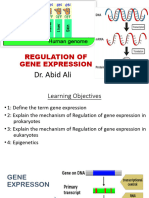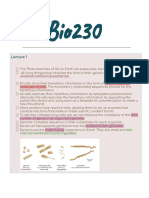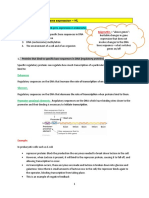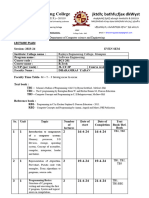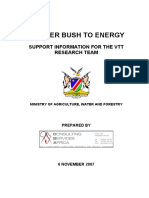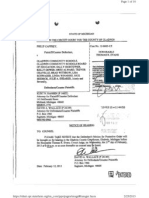Oxo ABioQ 08uu xs01 Xxaann
Oxo ABioQ 08uu xs01 Xxaann
Uploaded by
ajaelupCopyright:
Available Formats
Oxo ABioQ 08uu xs01 Xxaann
Oxo ABioQ 08uu xs01 Xxaann
Uploaded by
ajaelupOriginal Description:
Original Title
Copyright
Available Formats
Share this document
Did you find this document useful?
Is this content inappropriate?
Copyright:
Available Formats
Oxo ABioQ 08uu xs01 Xxaann
Oxo ABioQ 08uu xs01 Xxaann
Uploaded by
ajaelupCopyright:
Available Formats
8 DNA, genes, and protein synthesis
AQA Biology Stretch and challenge
Protein synthesis – the difference between
prokaryotes and eukaryotes
Specification references
• 3.4.2
Learning outcomes
After completing the worksheet you should be able to:
• compare protein synthesis in eukaryotes and prokaryotes
• explain how organisms regulate gene expression.
Introduction
Protein synthesis is a vital process for all living organisms. This worksheet looks at the
differences in this process between prokaryotic organisms and eukaryotic organisms. You will
be asked to assess the benefits of the different methods. You will also be presented with some
extra details of the process of protein synthesis.
Turning DNA into polypeptides
The process of protein synthesis has two main stages: transcription and translation.
Transcription is the process of making an mRNA copy of the DNA. Translation is the use of
mRNA and tRNA by ribosomes to synthesise a polypeptide chain. Although the processes are
similar in both prokaryotes and eukaryotes, there are some important differences.
Transcription in eukaryotes is more complicated than in prokaryotes. By far the biggest issue is
that the mRNA formed must be transported out of the nucleus before it can be used by the
ribosomes. Because of this, mRNA molecules must be short so that they can travel through the
nuclear pores. Once in the cytoplasm, mRNA molecules can become degraded and broken
down. In eukaryotes the mRNA molecules are modified while still in the nucleus to prevent this.
The average lifespan of a eukaryotic mRNA molecule is 10 minutes.
In eukaryotes, some of the DNA does not code for polypeptides. Some of these non-coding
regions can be found within coding regions, breaking up the code. They are called introns.
These non-coding introns are transcribed into mRNA but must then be removed. This is also
done before the mRNA leaves the nucleus.
© Oxford University Press 2015 www.oxfordsecondary.co.uk/acknowledgements
This resource sheet may have been changed from the original 1
8 DNA, genes, and protein synthesis
AQA Biology Stretch and challenge
In prokaryotes, transcription occurs in the cytoplasm. This allows the mRNA molecules to be
longer. The mRNA in prokaryotes is less modified as there is no need to protect it from
degradation, as translation happens almost immediately. This means the average lifespan of a
prokaryotic mRNA molecule is only 2 minutes.
Translation is almost identical in prokaryotes and eukaryotes. The biggest difference is in the
ribosomes. Eukaryotes have slightly bigger ribosomes but the structure is very similar.
Translation in prokaryotes can begin before the mRNA molecule has actually been finished,
with ribosomes working at one end and the transcription from DNA occurring at the other.
Owing to the length of the mRNA molecule, more than one ribosome can be translating the
mRNA at any one time. This combination of multiple ribosomes on the mRNA is called a
polysome.
Not all the genes on a piece of DNA may be needed by the organism at a particular time. Often
certain substances will not be made by an organism if they can get them from their
environment. To regulate the expression of certain genes, prokaryotes use a system by which
genes are organised into groups called operons. These are regulated by a gene that is
transcribed before the operon. This gene codes for a molecule that can block the transcription
of the operon under certain circumstances.
Questions
1 Summarise the differences between protein synthesis in eukaryotes and prokaryotes.
2 How are prokaryotic ribosomes different from eukaryotic ribosomes?
3 Why does prokaryotic mRNA have a much shorter lifespan than eukaryotic mRNA?
4 Describe a polysome and explain how they are useful.
5 Why is it important that prokaryotic mRNA does not need any modification after it has been
formed?
6 Explain why introns must be removed from the mRNA before leaving the nucleus.
7 Suggest why organisms regulate their gene expression.
8 What is an operon? Explain why they are important to prokaryotes.
9 Explain how the position of an operon regulator gene affects whether the operon is
transcribed or not.
© Oxford University Press 2015 www.oxfordsecondary.co.uk/acknowledgements
This resource sheet may have been changed from the original 2
You might also like
- EmSAT English HCT Preparation Course Practice Material PDFDocument81 pagesEmSAT English HCT Preparation Course Practice Material PDFBatool Mahmoud77% (30)
- Business Ethics PPT Unit 1Document29 pagesBusiness Ethics PPT Unit 1Dr.Srikrishna.GNo ratings yet
- Labor Rates ProductivityDocument9 pagesLabor Rates ProductivityBienvenida Ycoy Montenegro100% (1)
- Protein Synthesis - Activity Sheet PDFDocument2 pagesProtein Synthesis - Activity Sheet PDFjaneyzhouNo ratings yet
- Exercise 1Document6 pagesExercise 1Ano NymousNo ratings yet
- Bio Mod 3 Top 2Document2 pagesBio Mod 3 Top 2shaanspammailNo ratings yet
- Transcription Questions and Answers PDFDocument5 pagesTranscription Questions and Answers PDFabdulalemalnsefNo ratings yet
- Assignment For The Course Molecular Biology (Cheg 6181) On Regulation of Gene ExpressionDocument40 pagesAssignment For The Course Molecular Biology (Cheg 6181) On Regulation of Gene ExpressionBro Gi GisheNo ratings yet
- Regulation of Gene ExpressionDocument73 pagesRegulation of Gene Expressionm.alyanhanif563No ratings yet
- MBG 2021 - Lecture5Document63 pagesMBG 2021 - Lecture5Aysun AlizadehNo ratings yet
- Genetics - Chapter 14Document10 pagesGenetics - Chapter 14Renzth BlancNo ratings yet
- MU - T - Lec 9Document10 pagesMU - T - Lec 9Gilbert GumisirizaNo ratings yet
- BIO230 - Section 1 Regulation of Genome Expression Lecture 1-9Document36 pagesBIO230 - Section 1 Regulation of Genome Expression Lecture 1-9yusrawasim147No ratings yet
- Unit 2: The Molecular and Biochemical Basis of An OrganismDocument18 pagesUnit 2: The Molecular and Biochemical Basis of An OrganismRam Kewal TripathiNo ratings yet
- Translation NotesDocument26 pagesTranslation Noteshoedward29No ratings yet
- Chapter 18 Regulation of Gene Expression in Eukaryotes Part 1 PDFDocument15 pagesChapter 18 Regulation of Gene Expression in Eukaryotes Part 1 PDFbitarzainab30No ratings yet
- November 26 Cell and Molecular Biology NOVEMBER 26 2021Document21 pagesNovember 26 Cell and Molecular Biology NOVEMBER 26 2021shelahomero3No ratings yet
- Study Guide Cells To OrganismsDocument7 pagesStudy Guide Cells To OrganismsmikeschallraNo ratings yet
- L3 MLB 110 PROTEIN SYNTHESIS ATU CorectDocument18 pagesL3 MLB 110 PROTEIN SYNTHESIS ATU Corectmaxwell amponsahNo ratings yet
- 7.2 Transcription and Gene ExpressionDocument4 pages7.2 Transcription and Gene ExpressionAbdelrahman HarrathNo ratings yet
- Unit Test Study Guide 21-22 KeyDocument3 pagesUnit Test Study Guide 21-22 Keybraedenm102No ratings yet
- Regulation of Gene Expression in Eukaryotes: Md. Murad Khan Lecturer Dept. of Microbiology Jagannath UniversityDocument68 pagesRegulation of Gene Expression in Eukaryotes: Md. Murad Khan Lecturer Dept. of Microbiology Jagannath UniversityCharls John ErcilloNo ratings yet
- Exercise 2Document5 pagesExercise 2Ano NymousNo ratings yet
- TSS_WEEK 2_2024Document6 pagesTSS_WEEK 2_2024deepanryanNo ratings yet
- Regulation ReportDocument14 pagesRegulation Reportjeffersonmanalo787No ratings yet
- Kanzul Cell & Molecular BiologyDocument12 pagesKanzul Cell & Molecular BiologyMuhammad FarhanNo ratings yet
- The Role of MRNA Structure in BacteriaDocument7 pagesThe Role of MRNA Structure in BacteriasamsonNo ratings yet
- Chapter 9 (Protein Synthesis)Document15 pagesChapter 9 (Protein Synthesis)dellavajames192000No ratings yet
- Biology Test - QuestionsDocument12 pagesBiology Test - QuestionsMedawar CarpetsNo ratings yet
- Chapter 16 - Gene ExpressionDocument20 pagesChapter 16 - Gene ExpressionAyushi MauryaNo ratings yet
- 1. B 2.2 SL Organelles and CompartmentalizationDocument10 pages1. B 2.2 SL Organelles and CompartmentalizationSudden Destiny NyamasvingaNo ratings yet
- Module 4-From Gene To Protein Basic Molecular Genetic MechanismsDocument43 pagesModule 4-From Gene To Protein Basic Molecular Genetic MechanismsBelinda GeronimoNo ratings yet
- BIO302 Final TermDocument20 pagesBIO302 Final Termadnanmoon760No ratings yet
- Post-Transcriptional Modifications: Arun Kumar PHD Scholar Centre For Molecular Biology Central University of JammuDocument67 pagesPost-Transcriptional Modifications: Arun Kumar PHD Scholar Centre For Molecular Biology Central University of JammuARUN KUMARNo ratings yet
- Distinguish Between The Intersimple Sequence RepeatDocument12 pagesDistinguish Between The Intersimple Sequence RepeatthomasNo ratings yet
- Chapter 3Document43 pagesChapter 3Francis Bernard MalonzoNo ratings yet
- Molecular BiologyDocument9 pagesMolecular Biologyrifat RasheedNo ratings yet
- Why Learn About DNA Transcription and Translation?Document5 pagesWhy Learn About DNA Transcription and Translation?KempetsNo ratings yet
- Bfe Unit 4 10 MarksDocument11 pagesBfe Unit 4 10 MarksJohn AmnaNo ratings yet
- Genetics VanshDocument21 pagesGenetics VanshJatinNo ratings yet
- 05-02-Genetika MikroorganismeDocument48 pages05-02-Genetika MikroorganismeKinad DanikNo ratings yet
- Materi Genetik: Overview of Gene Structure, Transcription, Translation and Regulation of Gene ExpressionDocument32 pagesMateri Genetik: Overview of Gene Structure, Transcription, Translation and Regulation of Gene ExpressionNovi AndrianiNo ratings yet
- 7.2 7.3transcriptionandtranslationDocument30 pages7.2 7.3transcriptionandtranslationKhin (Darin) Hnin PhyuNo ratings yet
- New EukDocument24 pagesNew EuknikhilsathwikNo ratings yet
- Essay Explaining The Process of Protein SynthesisDocument8 pagesEssay Explaining The Process of Protein SynthesisClaudia Acosta100% (1)
- Ekspresi GenDocument63 pagesEkspresi GenIndraPramanaIdaBagusNo ratings yet
- The Central Dogma in Molecular BiologyDocument17 pagesThe Central Dogma in Molecular BiologysoffiahNo ratings yet
- Gene ExpressionDocument16 pagesGene ExpressionmidhunbonumahanthiNo ratings yet
- BIO302 Final Term Solved PapersDocument20 pagesBIO302 Final Term Solved Papersadnanmoon760No ratings yet
- Kuliah 9. Translation (Oke)Document35 pagesKuliah 9. Translation (Oke)Sinta DosiNo ratings yet
- Lecture 24-28Document9 pagesLecture 24-28Qᴜʀᴀᴛ Uʟ AɪɴNo ratings yet
- Prokaryotes and EukaryoticDocument8 pagesProkaryotes and EukaryoticYasirNo ratings yet
- Régulation de L'éxpréssion Génétique (1) - CopieDocument163 pagesRégulation de L'éxpréssion Génétique (1) - CopieWahuba RahmaniNo ratings yet
- Controlling Gene Expression: Inc. All Rights ReservedDocument90 pagesControlling Gene Expression: Inc. All Rights ReservedEllemrac GageloniaNo ratings yet
- Section 29.5eukaryotic Protein Synthesis Differs From Prokaryotic Protein Synthesis Primarily in Translation InitiationDocument3 pagesSection 29.5eukaryotic Protein Synthesis Differs From Prokaryotic Protein Synthesis Primarily in Translation InitiationEros CuestaNo ratings yet
- 11 5 2+Central+DogmaDocument13 pages11 5 2+Central+DogmaAbir HasanNo ratings yet
- SplitPDFFile 1 To 33Document33 pagesSplitPDFFile 1 To 33Rabia HanifNo ratings yet
- Chapter 1: General Principles of Cellular OrganizationDocument9 pagesChapter 1: General Principles of Cellular OrganizationWissam MoslehNo ratings yet
- q3l3 - 3ndquarter Science 10Document12 pagesq3l3 - 3ndquarter Science 10Billy Jasper DomingoNo ratings yet
- Module 1Document24 pagesModule 1Dumlao Ofrelyn RoseNo ratings yet
- Flujo de Información GenéticaDocument23 pagesFlujo de Información GenéticaKennyDeLosReyesNo ratings yet
- Gene Editing, Epigenetic, Cloning and TherapyFrom EverandGene Editing, Epigenetic, Cloning and TherapyRating: 4 out of 5 stars4/5 (1)
- Brotherhood Club 2015 ProposalDocument9 pagesBrotherhood Club 2015 ProposalO AfricaNo ratings yet
- Joe Perez - Tony Robbins AssessmentDocument22 pagesJoe Perez - Tony Robbins AssessmentJoey Perez100% (1)
- C Programming Lecture PlanDocument4 pagesC Programming Lecture PlandharamrajyadavNo ratings yet
- 21.1.6 Lab - Hashing Things OutsDocument7 pages21.1.6 Lab - Hashing Things Outsphuoctxse180189No ratings yet
- Descriptive Text of "Danaukembar (Twin Lakes) "Document13 pagesDescriptive Text of "Danaukembar (Twin Lakes) "WabilNo ratings yet
- RRLDocument4 pagesRRLshaiNo ratings yet
- Teaching Learning Materials: Distribution Summary of Tlms in DC Partner SchoolsDocument2 pagesTeaching Learning Materials: Distribution Summary of Tlms in DC Partner SchoolsJasper Niel Vicenta RamirezNo ratings yet
- Bibliography EditedDocument4 pagesBibliography EditedJesse John A. CorpuzNo ratings yet
- Swapno HRDocument17 pagesSwapno HRphotos backupNo ratings yet
- Invader Bush To Energy - Final Report of CSA Support Information For VTT - 06-11-07 - FinalDocument15 pagesInvader Bush To Energy - Final Report of CSA Support Information For VTT - 06-11-07 - FinalNyanyu NoahNo ratings yet
- Activity To Steps Conversion ChartDocument2 pagesActivity To Steps Conversion ChartlaltamaterNo ratings yet
- Gladwin Community School, Et. Al. Vs Phil Caffrey Motion For Protective Order (To Stop/prevent Mr. Caffrey From Communicating With Gladwin Community School, Et. Al.Document19 pagesGladwin Community School, Et. Al. Vs Phil Caffrey Motion For Protective Order (To Stop/prevent Mr. Caffrey From Communicating With Gladwin Community School, Et. Al.Sharman L. CaffreyNo ratings yet
- Conflicts PresentationDocument21 pagesConflicts PresentationJowee Ann MarquezNo ratings yet
- Avernum 4 - Manual - PCDocument44 pagesAvernum 4 - Manual - PCszitis100% (1)
- SQP 9 ANS Rachna SagarDocument10 pagesSQP 9 ANS Rachna Sagarviswaselvi09No ratings yet
- 03 Mini-Basketball Scoresheet GuidelinesDocument3 pages03 Mini-Basketball Scoresheet GuidelinesLei PaguiriganNo ratings yet
- Fluorimetry (Instrumental Methods of Analysis)Document13 pagesFluorimetry (Instrumental Methods of Analysis)mohapevaishali71No ratings yet
- PR Bautista 1st SemesterDocument6 pagesPR Bautista 1st SemesterReinee Mae Rojo SindayenNo ratings yet
- Saroj Raj Upreti Sagar Bhatta Kalika Prasad MarahattaDocument12 pagesSaroj Raj Upreti Sagar Bhatta Kalika Prasad MarahattaGift SimauNo ratings yet
- Detailed Lesson Plan (DLP) Format: Learning Competency/ies: CodeDocument4 pagesDetailed Lesson Plan (DLP) Format: Learning Competency/ies: CodeREZEL SEMILLANONo ratings yet
- What Do You Know About Inorganic Zinc CoatingsDocument14 pagesWhat Do You Know About Inorganic Zinc CoatingsSasha Ziza100% (1)
- Certificate of Appreciation: Republic of The Philippines Republic of The PhilippinesDocument7 pagesCertificate of Appreciation: Republic of The Philippines Republic of The PhilippinesNanaNo ratings yet
- CBR KALKULUS KelompokDocument40 pagesCBR KALKULUS KelompokJonipar MuntheNo ratings yet
- ARLDDocument4 pagesARLDًNo ratings yet
- Executive SummaryDocument20 pagesExecutive SummarySamNo ratings yet
- Q1. Comment On The Beauty of Juliet Described by Romeo at The Beginning of The ExtractDocument5 pagesQ1. Comment On The Beauty of Juliet Described by Romeo at The Beginning of The ExtractThao Thanh PhamNo ratings yet
- BumberDocument8 pagesBumberPoliceabuse.comNo ratings yet








